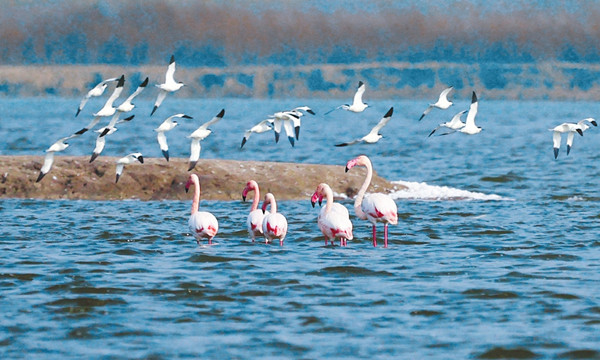Shanxi remains committed to ecosystem rejuvenation
Updated: 2021-09-01

Flamingos forage for food in the Salt Lake of Yuncheng city in Shanxi province. [Photo/Shanxi Daily]
North China's Shanxi province has seen an increasingly stable ecosystem in recent years – the result of its push to realize the harmonious coexistence of civilization and nature.
To achieve the goal, Shanxi has focused on pollution prevention and control and comprehensively improved its environmental quality.
From January to August this year, the average concentrations of PM2.5 – airborne particulate matter 2.5 micrometers in diameter or smaller, harmful to people's health – reached 39 micrograms per cubic meter.
It was the first time that PM2.5 concentrations had declined to the 30+ range since Shanxi fully implemented its PM2.5 monitoring in 2013, marking an historic breakthrough in its air quality.
In 2020, the water quality at all the national surface water assessment sections of the Fenhe River basin exceeded Grade V – the lowest level in China's five-tier system of standards.
The safe utilization rate of contaminated farmland in the province reached 97 percent last year, while the safe utilization rate of contaminated plots was 90 percent.

Taihang Mountains offer lush, sweeping views to visitors. [Photo/Shanxi Daily]
The province has also coordinated the conservation of its mountains, waters, forests, farmlands, lakes, grasslands and sands.
It has done so by implementing Three-North Shelterbelt Forest Program, ecosystem protection and restoration projects in Taihang Mountains, Lyuliang Mountains and basins of seven major rivers throughout the province, as well as the control and treatment project for sandstorm sources in the Beijing-Tianjin region.
As a result, soil erosion in the ecologically fragile area of Lyuliang Mountains has been effectively controlled and water resources in Taihang Mountains have been protected. Elsewhere, the wind-proof and sand-fixing measures along the Yanshan-Great Wall have been strengthened, while forest vegetation coverage in the basins of seven major rivers throughout the province has been greatly increased.
So far, Shanxi has established 272 nature reserves at or above the provincial level, with their area accounting for over 10 percent of the province's total area.
There are 2,743 species of wild plants and 541 species of terrestrial vertebrate wild animals that have been identified in Shanxi, including rare endangered species such as brown eared pheasants, black storks and North China leopards. Around 85 percent of the province's wild animals and plants are now effectively protected.

The now-pristine Fenhe River flows gently through Shanxi province. [Photo/Shanxi Daily]



